Lesson Nine: Settlers and Societies in California and Oregon
In the early 1990s a joke began making the rounds in the Pacific Northwest, and it went something like this. Three men were sitting around a campfire drinking. One was from Texas, one was from California, and one was from Oregon (or, in some versions, Washington). The Texan took a few swigs of whiskey, threw the bottle up into the air, and shot at it with his pistol while exclaiming, "We have plenty more whiskey where I come from." The Californian thought a minute, sipped a bit of Napa Valley wine, grabbed the Texan's pistol, threw the wine bottle up into the air, and shot at it while exclaiming, "We have lots more wine where I come from." The Oregonian (or Washingtonian) guzzled a whole bottle of Northwest microbrew, grabbed the Texan's pistol, threw the empty into the air but then caught the bottle in one hand and shot the Californian dead with the other, and explained, "We have too many Californians where I come from, but I need to recycle this beer bottle."
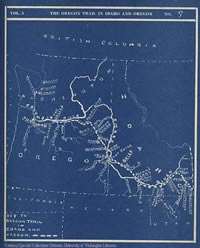
One could no doubt argue that this joke is tasteless and that it trivializes violence. It is mentioned not to endorse it but to provide evidence of what seem to me to be fairly widespread attitudes toward Californians on the part of people in the Pacific Northwest. I wish to note as well that these attitudes—and humorous expressions of them—have been of long standing. Perhaps the first anti-California joke in the Pacific Northwest appeared in the 1850s, and it went something like this: Migrants on the overland trail encountered a number of forks in the road. "At Pacific Springs, one of the crossroads of the western trail, a pile of gold-bearing quartz marked the road to California; the other road had a sign bearing the words 'To Oregon.' Those who could read took the trail to Oregon." (Cited by Dorothy O. Johansen, "A Working Hypothesis for the Study of Migrations," Pacific Historical Review 36 [Feb. 1967]:8.)
Jokes such as these have lasting currency in the Pacific Northwest because they confirm the region's belief and desire that it remains distinctive from California. Ostensibly offered as criticisms of the Golden State, these jokes are really told to point out what we regard as our own virtues. They tell us about who we are or, more accurately, about who we think we are. There is some truth to the idea conveyed in this humor that the Northwest and California have long been two different kinds of places and societies. At the same time, however, it seems to me that Northwesterners have tended to overemphasize these differences while underplaying the similarities and linkages between their region and California.
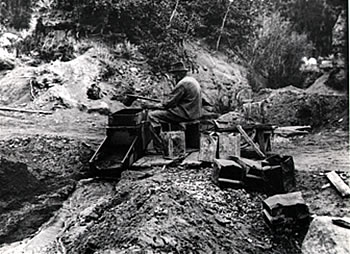
Historians have written especially on settlers and societies in California and Oregon during the 1840s and 1850s, trying to detect differences during the critical early years of these two American states. They have found ample grounds for confirming the founding of two distinct societies. At bottom, they agree, early American Oregon was shaped profoundly by the fact that immigrants were attracted primarily by the ample, fertile farmland in the Willamette Valley, while early American California was shaped profoundly by the fact that immigrants were attracted primarily by the presence of gold. Prior to the discovery of gold in California in 1848, Oregon was the favored destination of overland migrants to the West Coast. Between 1840 and 1848, 11,512 migrants headed for Oregon (or 81% of the total population in motion) while 2,735 headed for California. Once news of the gold strike reached across the continent, these percentages were reversed while the figures grew enormously. Between 1849 and 1860, 200,335 overland migrants headed for California (79% of the total population on the trails) while 53,062 headed for Oregon. (Figures from John D. Unruh, The Plains Across: The Overland Emigrants and the Trans-Mississippi West, 1840-1860 [Urbana: University of Illinois Press, 1979], 84-85.)
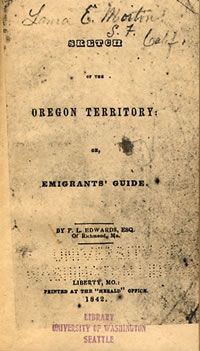 Placer Miner (above), Helena, Montana. While this view shows a
placer miner near Helena, it also illustrates the work of
California gold-seakers. (University of Washington Special
Collections, Mining Files, UW Negative #278).P. L. Edwards, Sketch of the Oregon Territory, or Emigrant Guide (right). Liberty, Missouri, Herald, 1842. (Special Collections, University of Washington)
Placer Miner (above), Helena, Montana. While this view shows a
placer miner near Helena, it also illustrates the work of
California gold-seakers. (University of Washington Special
Collections, Mining Files, UW Negative #278).P. L. Edwards, Sketch of the Oregon Territory, or Emigrant Guide (right). Liberty, Missouri, Herald, 1842. (Special Collections, University of Washington)
The discovery of gold, then, dramatically rearranged the quantity of migrants heading west and the quantity of migrants going to specific places in the West. It also introduced more qualitative differences into the stream of people moving overland. Those traveling overland to Oregon and California in the mid-1840s, their minds for the most part on starting farms in the Far West, included many more women and children. About half of all migrants in this period traveled the trail as members of family groups, and adult women comprised 15-20% of all emigrants. During the 1850s, by contrast, only 20-30% of all emigrants traveled the trail as members of family groups; and women and children amounted to no more than five percent of all emigrants bound for Gold Rush California during that decade.
In sum, then, families and farms tended to define society in Oregon, while males and miners tended to define society in California. Other differences accrued. Migrants to Oregon appeared to be more careful in how they got information about western destinations and how they moved across country. That is, they relied more than Argonauts on information obtained first-hand from personal acquaintances, and their families traveled across the trail more commonly with others from their extended families, towns, churches, or other group of acquaintances. By contrast, migrants to California made the decision to move with less care and caution, coming much more frequently as individuals and depending more upon less reliable printed materials for their information about the coast. Once they arrived at the end of the trail, moreover, California-bound emigrants proved much more mobile, moving around from place to place seeking opportunity, and also leaving the state more readily to return home or head for some other supposed strike. California seems to have been more restless, Oregon more steady.
Historians of early American Oregon and California have detected important differences in economic, political, and environmental attitudes that mirror these demographic differences. Oregon's early settlers had to some extent intentionally left behind the nation's growing market system and its increasing commercial orientation. They participated in commerce, to be sure; indeed, their farms prospered in the late 1840s and early 1850s, in large part because they could sell so much produce to miners in more grasping California. But Oregon's farmers did not embrace market capitalism wholeheartedly. The historian Robert Bunting explains:
Settlers approached markets cautiously, for although farmers wanted outlets for their surpluses, few were unlimited marketers merely awaiting the structures that would make profit maximization possible. Settlers farmed according to the "Oregon fashion," which sought to take advantage of market exchange while minimizing market risk. They accomplished their goal through raising a variety of crops and animals designed to meet household needs first and marketing only the surpluses....
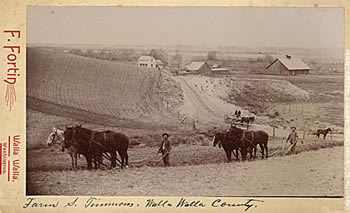
Emigrants entering [Oregon] from the 1840s to the 1880s...were families in search of health and abundant land upon which they could establish permanent homes. Oregonians clearly recognized these goals as an important feature of their society and a significant element in framing a distinctive self-identity. L. F. Grover, in an 1853 Fourth of July speech, contrasted Oregon's steady progress with California's fluctuating periods of rapid growth and declines. For Grover, Oregon's superiority clearly rested with its "permanent population, characterized by intelligence, industry and wealth." Or, as Oregon Superintendent of Indian Affairs Anson Dart proudly noted, Oregon proved a poor country for "doctors, lawyers, clerks, speculators and gamblers." The Pacific Raincoast: Environment and Culture in an American Eden, 1778-1900 (Lawrence: University Press of Kansas, 1997), 92.
The farm of S. Timmons, Walla Walla County, n.d. (Special Collections, UW, Agricultural Files. Photo by F. Fortin, Walla Walla, UW negative #8310.)
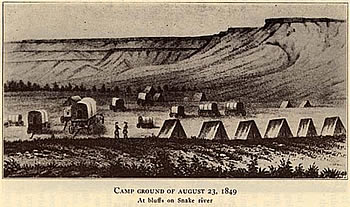
Camp Ground, Aug. 23, 1849. Raymond W. Settle, ed., The March of the Mounted Riflemen, First United States Military Expedition...to Fort Vancouver,...1849. As recorded in the journals of Major Osborne Cross and George Gibbs and the official report of Colonel Loring. (Glendale, 1940)
Settlers in Oregon placed somewhat more emphasis on community than did most other Americans of the time, and less emphasis on individual gain. "Landownership and a familial competence, more than the profits of personal self-seeking, provided the critical incentive to the settling of the land," writes David Alan Johnson in Founding the Far West: California, Oregon and Nevada, 1840-1890 (Berkeley: University of California Press, 1992), 139. Johnson goes on to point out how this economic orientation played out in a more "republican" politics in Oregon, as manifest in that state's constitution upon admission to the Union in 1859. He also contends that Oregonians resisted the modernizing changes of the later 19th century:
Except in a small way, Oregon lacked the mineral wealth that, transformed into capital, shaped California long after the mines played out. Pacific Northwesterners remained wedded to farming, and as farmers their embrace of market agriculture was subdued even after the isolation of the early decades ended. Although commercial farming increased in the 1870s, 1880s, and 1890s—most importantly east of the Cascade mountain range—the older mixture of subsistence and market family farming in the Willamette Valley continued long after the 1850s. This was the case to no small degree because of the persistence of the early comers to the state. With the exception of those who briefly sojourned in Oregon during its mining rushes in the 1860s, life there was marked, if not dominated numerically, by those who stayed behind. (Johnson, 270)
Throughout Johnson's and Bunting's comments, the contrast between Oregon and California looms large. The two places attracted different kinds of settlers who decided about and traveled to these destinations in different fashion and then developed political institutions and social attitudes that reinforced their differing world views. Many Oregonians would argue that these early distinctions have persisted to the present, that the fork in the overland trail (now a junction of the interstate highway) continues to symbolize a powerful division.
There is a good deal of truth to the idea that California and Oregon (and, by implication, the Pacific Northwest) traveled along different paths toward the present. However, I would not want to stress the point too much. There is a case to be made, too, for similarities between the two subregions of the West. Consider for example the fact that many observers reported that farms throughout the Willamette Valley seemed deserted in 1849-1850 because so many people—especially the men—had left to seek their fortunes in the Gold Rush. James Douglas, an officer in the Hudson's Bay Company, estimated in 1849 that two-thirds of Oregon's settlers had abandoned their farms in search of California gold. Benjamin Cory, a doctor and miner based in San Francisco, commented similarly that "News of the gold has extended like wildfire. Every ship from the Sandwich Islands [Hawaii], Oregon, and the Southern Coast is loaded with passengers—Oregon is dead...." If settlers in the Willamette Valley were so virtuous, so impervious to the lure of gold, then why did they mimic the behavior of Californians?
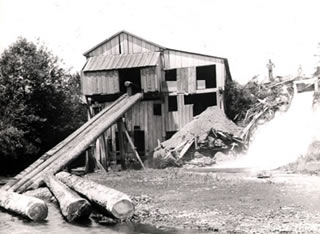
Right: Allegedly the first sawmill on Puget Sound; built by William Shelton, an Indian on the Tulalip Reservation. (Special Collections, UW, Logging Files. Photo by Norman Edson, Burton, Washington.)
Other complicating factors deserve our attention as well. First, just as Oregon's settlers did not remain in Oregon, so the gold rush did not stay confined to California. It spread northward into southern Oregon during the early 1850s, bringing many "Californian" habits and attitudes with it. Thereafter miners lit out from California for additional strikes (or rumored strikes) in eastern Washington, southern British Columbia, central Idaho, and western Montana between 1855 and 1864. In other words, the Pacific Northwest played host to mineral rushes, too, and in some cases profited quite handsomely from them. Second, the gold rush made California into such a powerful force that it utterly dominated the economies of the surrounding area, including those in the Pacific Northwest, regardless of how residents of the region felt about it. Farming in Oregon and logging in Washington and British Columbia—the region's two leading industries—prospered primarily because of the markets for produce and lumber that existed in California. Moreover, investment in, and control over, the economies of the region came primarily from, or by way, of San Francisco. As economic theorist Henry George explained in 1868, "Not a settler in all the Pacific States and Territories but must pay San Francisco tribute; not an ounce of gold is dug, a pound of ore smelted, a field gleaned, or a tree felled in all their thousands of square miles, but must...add to her wealth." Third, although family farming in the Willamette Valley no doubt set the pace for the Northwest during the 1840s and early 1850s, extractive industries became much more the norm thereafter. Fishing, mining, logging, and corporate agriculture all made the Pacific Northwest more like California and less like the Willamette Valley as the decades passed during the late 19th century.
The Willamette Valley society of the 1840s remained influential, but over time it also seemed more and more exceptional and ephemeral. Urban and industrial society in Portland and Seattle and Vancouver and Spokane, for example—more similar to California in its higher proportion of men and singles in the society, its greater focus on resource industries, its more diverse population—marked the new direction of the Pacific Northwest. Ironically, though, this newer Northwest remained as devoted as the older Northwest to anti-California jokes and to the underlying sentiment that people to the north of the 42nd parallel—the northern boundary of California—remained different from, and no doubt better than, those to the south.
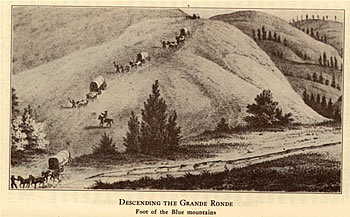
Descending the Grande Ronde, Foot of the Blue Mountains. Raymond W. Settle, ed. The March of the Mounted Riflemen. As recorded in the journals of Major Osborne Cross and George Gibbs and the official report of Colonel Loring. (Glendale, 1940), facing p. 226.
The migration of people is neither a random nor a chaotic process. Those who moved to the Pacific Northwest by no means comprised a cross-section of the societies back east that provided the majority of the emigrants. Rather, migration was a selective process. Some people, such as those with some resources with which to pay for a journey, were able to go while others were not. Similarly, some people chose to go while others with the same amount of resources did not. There were reasons for the choices that were made, reasons that fell into patterns that can be explained through historical analysis. (One should add here that, as we are speaking about the mid-19th century, it is important to note that male heads of household had far more power in shaping decisions about migration than did women or children. For supporting evidence, see John Mack Faragher, Women and Men on the Overland Trail [New Haven: Yale University Press, 1979] and J. S. Holliday, The World Rushed In: The California Gold Rush Experience [New York: Simon and Schuster, 1981].) Moreover, the destinations at the end of the overland trail attracted some migrants but not others. Farm land in the Willamette Valley appealed particularly to some kinds of migrants, while the presence of gold in the foothills of the Sierra Nevada appealed particularly to other kinds. And so different types of societies emerged in the Far West of the mid-19th century. Yet the two kinds of societies would clearly overlap and interact. Californians and Northwesterners would regularly cross the borders that supposedly set them apart. People would also change their minds, for a variety of reasons, and become more or less devoted to mining, or to farming, or to some other activity or place.
More importantly, while migration allowed the choices of some individuals to create differences in the kinds of settler societies that took root in the Far West, there were other quite powerful forces at work that profoundly shaped all colonization in the region. Some were national and some were international. For example, Californians and Oregonians both sought to improve their condition and that of their families within a generally shared framework of modern, global, market capitalism that encouraged the movement of individuals and families across increasingly vast distances. For example, Californians and Oregonians brought to the Far West a common political ideology of the republic of the United States, along with the mutual expectation that American laws and courts, and American policies regarding natural resources, would provide the framework for economic and legal development in newly colonized country. (This ideology, after all, had been at the root of American settlers' complaints about the Hudson's Bay Company in the Pacific Northwest.) For example, Californians and Oregonians brought with them a shared complex of beliefs—religious, scientific, legalistic, economic—that defined in their minds quite clear racial and cultural distinctions between themselves and such groups of "others" as Indians and Mexicans and Chinese. Indeed, when American settlers in the Pacific Northwest began drawing "lines"—i.e. borders between themselves and Canadians, boundaries marking off Indian reservations, grids that gave coordinates to specific tracts of property—they provided evidence of the great number of common features that set them apart as American colonizers of the West. The importance of these lines forms the subject of the next lesson.
| Course Home | Previous Lesson | Next Lesson |